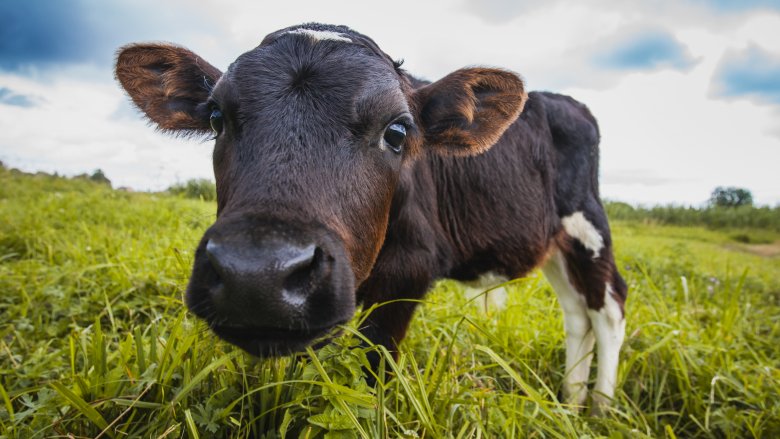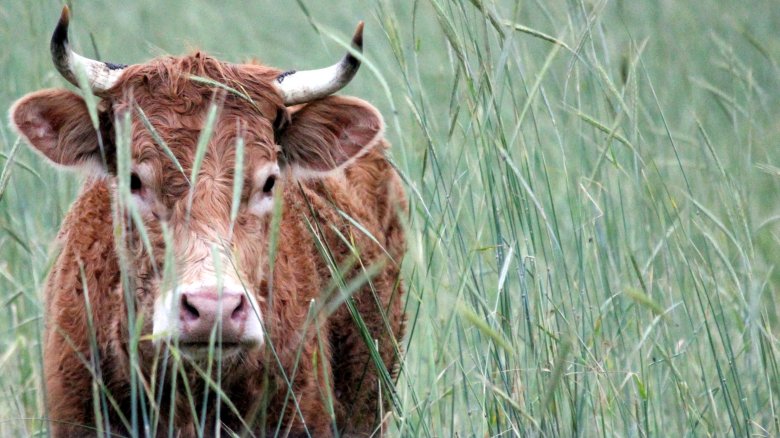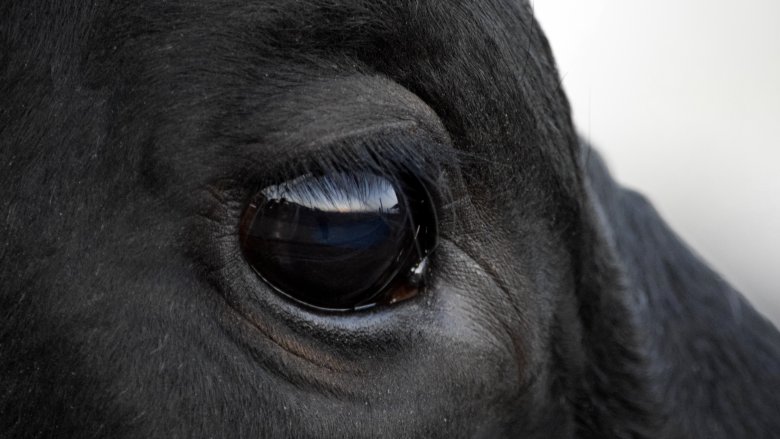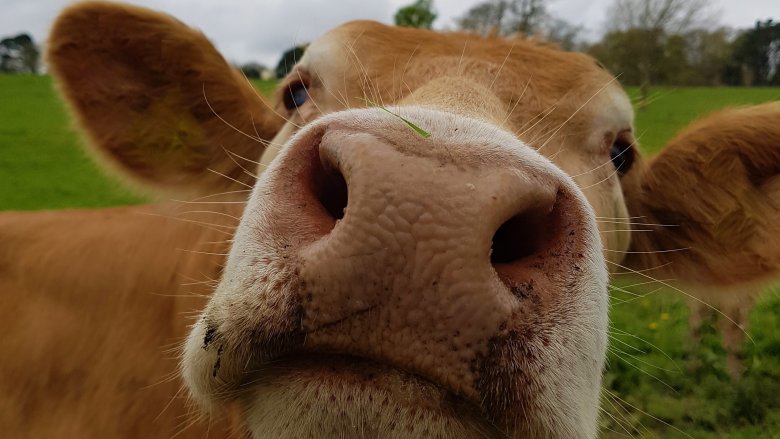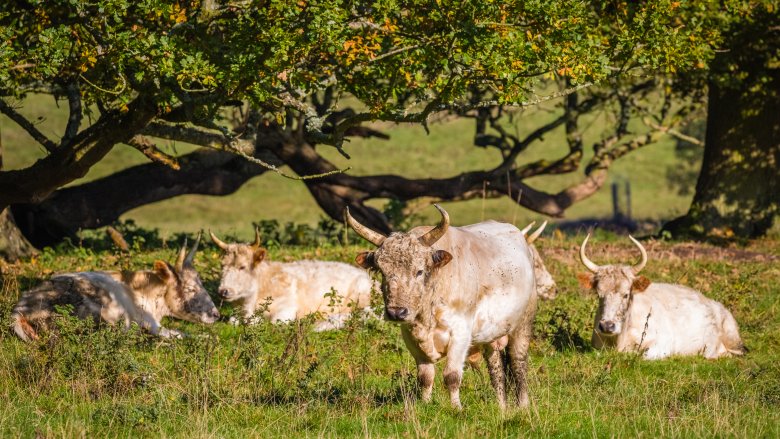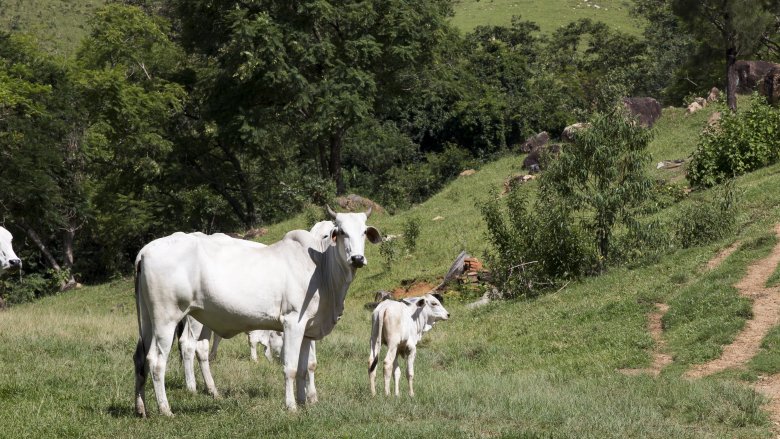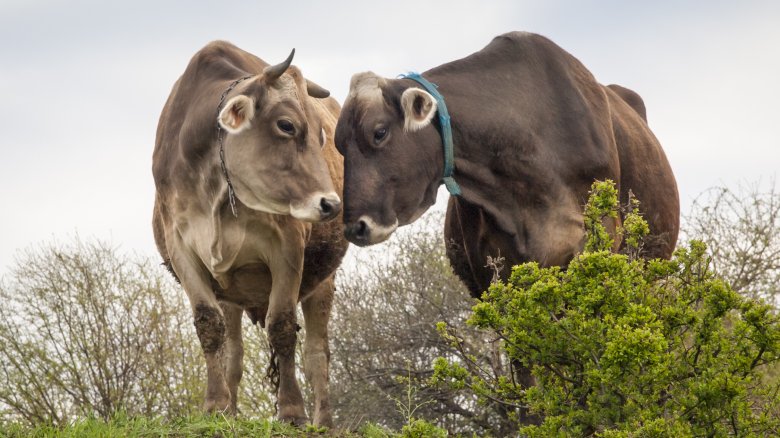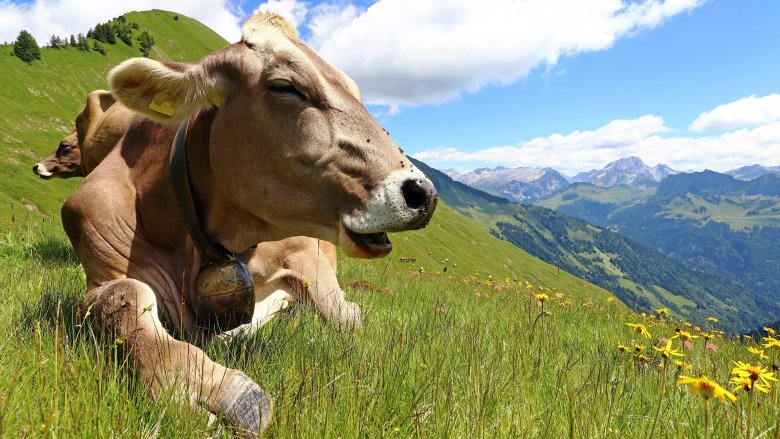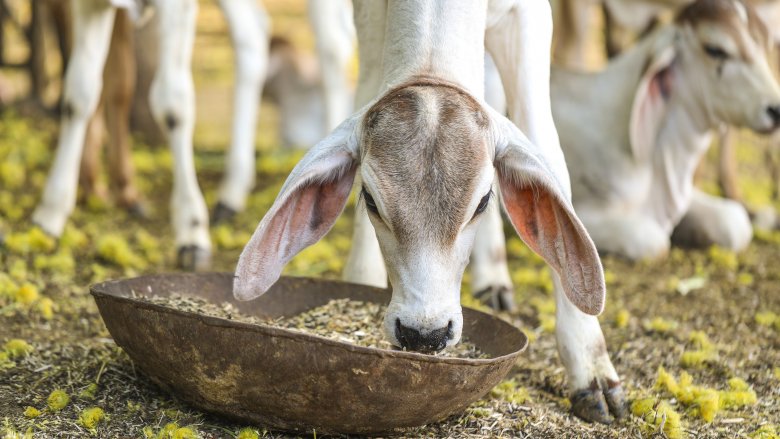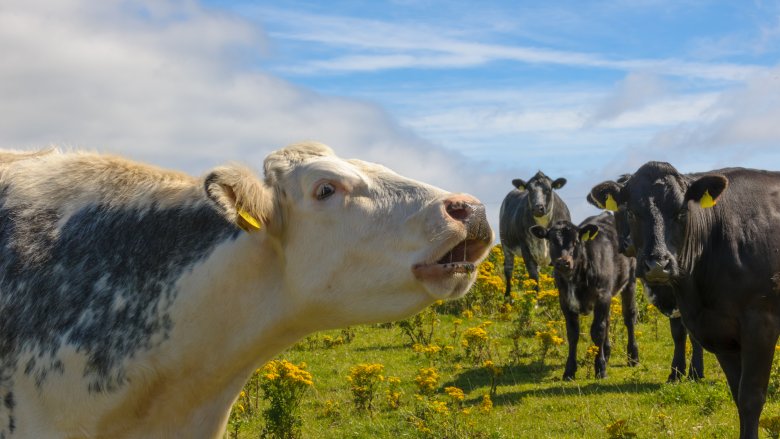The Real Reason Cows Moo (And Other Cool Cow Facts)
It's really too bad cows had the misfortune to be made of tasty, tasty beef. Too bad for them, but awesome for most of us. Whether you believe cows are meant for eating, for milking, or for just admiring, you can't deny they're fascinating creatures. Just how fascinating? You might be surprised.
Cows can't be tipped
You probably know someone who swears they had a college roommate with a brother who once went cow tipping for fun or maybe your ex-girlfriend's idiot cousin regales you with cow tipping stories at every family get-together. That doesn't mean cow tipping is possible. It means those people are lying.
Do you know who's saying that? Science (and Sheldon Cooper). Even if you don't believe him, you've got to believe the math done by a team from the University of British Columbia (via Modern Farmer). They looked at how much force a single person can generate and how much force would be needed to actually push a cow over, factoring in the direction of force, the cow's center of mass, and more. Long story short: 1,360 Newtons of force would be required to tip a cow, and a 145-pound person can only generate 660 Newtons.
That's even assuming the cow is compliant in the whole thing. Cows don't sleep standing up, and as prey animals that are always on the lookout, they're hard to sneak up on. Factor in the cow trying to stay on her feet, and you'd need five or six average people to come close to the required amount of force. By then, Bessie has lumbered off and at least one of the drunken, would-be cow tippers has probably puked on his own shoes.
Cows have crazy vision
You probably don't think about the way a cow sees the world, but it's pretty incredible. Those big, beautiful eyes give cows a range of sight that's an almost unthinkable 300 to 330 degrees. The only place Clover can't see without moving her head is directly behind her, which she needs as a grazing prey animal. There is a drawback, though. According to the Cooperative Extension of the USDA, cows lack depth perception.
Cow vision is cooler still, and according to a 2015 study done in Australia (via Drovers), each one of a cow's eyes is strongly connected to the opposite side of the brain. The right brain — which tells the cow when she should be afraid and when she should run — is connected to the left eye, so when cows are checking out something they're afraid of, they'll often use their left eyes to accurately assess threats. The right eye is connected to the left brain, which tells the cows what to do when life isn't throwing any curveballs. Cows that trust their caretakers will use their right eye to look at them. Generally, more dominant cows are less fearful and use their right eyes more often. It's unclear which eye is used for come-hither winking.
Cows can smell things that are miles away
It might not be the worst thing that can happen at work, but Janet from accounting making her microwave popcorn every afternoon is definitely on the list. Thank your lucky stars you're not a cow, because you could smell popcorn — and anything else — from 6 miles away.
According to Modern Farmer, cows use their sense of smell for everything from tracking their babies to assessing a potential mate. The cow's nasal sensitivity is due to something called the Jacobson's organ. ThoughtCo says humans have it, too, but ours doesn't really work.
We obviously can't ask cows what they think of our particular smell, but anecdotal evidence suggests they may not like things like our fancy colognes and perfumes. (Hard to blame them.) Some farmers suggest they have an adverse reaction to things like scented laundry detergents, so what's the modern cowboy to do? If you're wondering whether there's a fragrance that makes humans smell pleasant to cows, there totally is.
The Nazis bred super-aggressive cattle
No matter how much you think you know about the Nazis, the Third Reich will continue to prove itself a crazy Pandora's box that just keeps on giving. A zoologist named Konrad Lorenz claimed domestication was ruining animals. Their wild ancestors were more beautiful and biologically pure, he said, and you can probably see where this is going.
Cabinet magazine says what followed was the idea of creating a game reserve in Poland that would be home to animals reverse-engineered into their ancient ancestors, including ancient cows called aurochs. Those died out in the middle of the 17th century, so a 20th-century breeding program led by Lutz and Heinz Heck created an aurochs-like breed called Heck cattle or Heck aurochs.
The brothers took the postwar survival of some of the cattle as a sign of the superiority of the breed because of course they did. Heck cattle are still around, and they're super-insane, as one English farmer found out the hard way. Derek Gow told the BBC he ended up slaughtering 20 of his aurochs because they were too aggressive to handle safely. In 2017, CNN reported that the Tauros program, conceived in 2008 with the idea of reverse-engineering aurochs, was going quite well. If there's anything you can say for the human race it's that we don't learn.
There's a herd of super-rare, completely wild cattle in England
You're familiar with those docile-looking black-and-white cows that are all over rural America, right? These aren't them.
Chillingham Castle Park in Northumberland, England is home to a herd of around 100 souls aptly called the Chillingham wild cattle. They roam over 360 acres, and while there's an overseer that keeps an eye on them and makes sure they're safe from outside interference, these tough, rugged, 100 percent wild cattle have never been touched by humans or cared for by a vet.
Even more impressive is how long they've been there. According to the BBC, the park was fenced off in 1240 with a herd of cattle inside that's been there ever since. The Natural History Society of Northumbria says they've remained unchanged, and their relatively small but stocky bodies are a pretty perfect example of what most cattle would have looked like throughout the Middle Ages. They've kept their medieval behavior, too, birthing calves away from the herd and hooting as well as mooing. Every year, these living relics weather the rough winters and wet summers the same way their ancestors have since the days of Columbus, Elizabeth I, and Henry VIII.
We domesticated them about 10,500 years ago
According to ThoughtCo, the history of our relationship with cattle is pretty confusing. Let's break it down a bit. It's believed we domesticated aurochs in two major events: one happened about 10,500 years ago in the Near East, and the other happened about 7,000 years ago in the Indus Valley. Those cattle eventually spread to Europe, where they bred with the native auroch population there.
Aurochs and cattle have always been important to us — there's a reason they're featured in so many cave paintings and so many works of ancient art. Weirdly, dairy cows were more useful to our Neolithic ancestors than they are to us today. While a decent percentage of today's humans can't digest lactose, that genetic trait hadn't developed when we were domesticating cattle.
We weren't going around waving our domesticating wand all over the place, either. When University College London researchers (via ScienceDaily) took a closer look at that first domestication event, they were able to trace the DNA of modern cattle back to reconstruct the DNA of the original herd. It seems we first domesticated about 80 individuals. The idea of catching 80 of these wild, massive, probably angry animals is enough to make you want to have a beer with the folks that did it.
Cows are deeply emotional animals
Sure, you know your dog has feelings – try petting another dog as he's watching through the window and see how well that works out for you. But cows have feelings, too. If you don't want to believe your bacon cheeseburger was once someone's best friend, you're living in denial.
A study done at Northampton University (via Barn Sanctuary) measured the heart rate of calves that were paired up with another calf they were seen regularly hanging out with and then with an unfamiliar calf. They were way more relaxed when they were chilling with their bestie, which supports other research from the University of British Columbia that found calves who spent most of their time with their friends were better at reasoning out new challenges. According to Wired, research has suggested cows are deeply emotional, too. When babies are separated from their mothers at a young age (standard practice for dairy cows), they both grow depressed and (believe it or not) pessimistic. They'll stop eating and show other signs of stress. How can you do that to that adorable face, you monster?
Not only that, but according to Applied Animal Behavior, the University of Cambridge has shown that cows paired up and presented with a task will react to each other based on how successful they are, and they'll get super-excited when they figure things out. How adorable is that?
Cows enjoy music and it impacts milk production
It's a dark soul that believes a little bit of jazz music doesn't make the day a little brighter, and cows? Cows are all about the jazz and REM, as researchers at the University of Leicester found out.
In 2001, researchers (via Modern Farmer) took a look at just how listening to music impacted dairy cows, and they found when music like REM and Simon & Garfunkel was played for cows, they produced around 3 percent more milk. When cows are stressed, they release less oxytocin, which is crucial for the milk-making process. Happier cows are more productive cows. Because humans are inherently selfish animals, we now have plenty of research on how to make cows happy. In addition to soft, slow music (fast-paced music didn't have much effect), another study found milk production increased when cows were read Shakespeare. Specifically, they enjoyed a theatrical reading of The Merry Wives of Windsor, so even if you didn't enjoy The Bard when you had to read him in high school, at least Buttercup appreciates his talents.
What's with the cud?
Every time you look at Sweet-Dee-Marie the Triple Baconator (what do you name your cows?), she's chewing her cud. You've probably heard the term and know it has something to do with their stomachs, but it's actually a pretty cool adaptation that's helped them thrive as giant prey animals.
Cows are ruminants, which means their stomachs have four chambers. They only chew a bit while they're grazing then send the food into the first chamber, called the rumen. There, it's softened and formed into chunks of barely chewed food, called cud. Eventually, they'll regurgitate the cud to finish chewing. According to Cattle Empire, cows can pull off 40,000 chews a day.
It's hugely practical; cows can graze when they have the opportunity and chew later to get the most nutrition out of what they're eating. If they're ambushed by a predator and need to run, they've already got food stores from that awesome patch of clover earlier. They only chew their cud when they're relaxed, and according to the University of Kentucky College of Agriculture, this is a great way to tell just how chill your herd is. Still grossed out? Even if it is regurgitated food and stomach acid, you can't say it's more disgusting than chewing tobacco.
You can feed them (lots of) candy
Ever ponder switching to an all-candy diet? Or even a mostly candy diet? It's worth thinking about, until you remember how bad you felt last Halloween. Prepare to be jealous because John Waller, an animal nutrition professor at the University of Tennessee (via LiveScience), says cows can survive quite happily on a candy-heavy diet, plus some minerals for balance. They can process proteins, carbs, and various minerals out of a candy-heavy diet, and some farmers have been doing this since at least 2012.
In 2017, a massive Skittles spill was reported in Wisconsin. News! Turns out, the Skittles were livestock feed, which left a lot of people with a lot of questions. It turns out that not only is it more economical for some farmers to supplement cow diets with candy (and cookies, hot chocolate mix, and sprinkles) than with other foods, it's good for cows to have as much as 5 percent sugar in their diets. It helps with their digestion, and some farmers don't even unwrap the candy first — the cows seem to be able to handle that, too. Sounds like a pretty good diet. Who's looking forward to the first cow-to-human stomach transplant?
Why do cows moo?
No countryside setting is complete without the gentle moo of a cow, and if you've ever wondered just what they're saying to each other, you're not alone. Jared Decker, a cattle geneticist from the University of Missouri (via NPR), wondered the same thing. He says cows moo a lot when they're moved to a new location, and he thinks they may be calling out for familiar cows, trying to make sure their besties made the trip with them. They also moo — a lot — when they're looking for their calves, their moms, or their mates. Pretty similar to humans. And they moo a lot when they see the farmer because food.
According to the BBC, researchers from Queen Mary University of London and the University of Nottingham were able to isolate a few distinct cow sounds. The sound Mama Cow makes to find her calves was different than the call the calves made to say they were hungry, for example. Researchers also found different cow pairs used different voices and sounds to communicate. There's a wide range of frequencies of moos, and it all seems to suggest that the social life of cows is way more complicated than we know. It might even be more complicated than yours.
